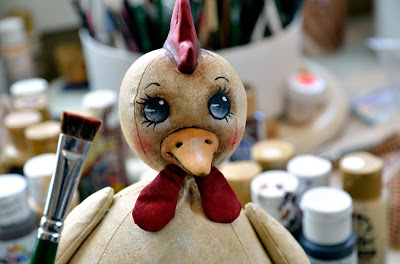NOTE: I added more descriptive photos of the wire feet being made. This was added to part 1 if you want to go back and check that out.
I am going to prepare the feathers. I always have my coffee mixture made up and ready to use. The feathers I have used are the boas you buy in the craft store. Of course this stark white will not cut it, this is a prim hen after all. lay the feathers on a foam plate and saturate them with coffee, use your brush to get the coffee everywhere.
Here are the feathers all wet and looking pretty bad. Let them dry and fluff them a bit with your fingers as they dry.
I have glued the feathers on the neck and one leg in this picture, I love how this looks. You can see the comparison of how plain the other leg looks without them. I used fabri-tac glue here and held the feathers in place with straight pins until dry then pulled them out.
Adding little bits of feathers randomly around the comb adds even more whimsy. I finished her off by adding small strips of feathers on top of each wing. Does she look a bit put out and bored here? She is so done already with me messing with her!! LOL
She needs some eggs for her bucket. I covered small foam balls with clay, shaped them and let them dry. Once dry they are sanded, sealed and painted with acrylics.
Here are my painted eggs. I mixed them up by making some darker and some lighter. I speckled the eggs in the same way I did the chicken.
I am checking to see if this is the look I am after, I do like it! I glue each egg in place. The eggs are sitting on top of foam that is topped with moss. Next I will make the sign.
for the sign I am using a thin wood tag from the craft store. I simply cut off the end with the hole. I then took a candy apple stick and glued it to the back. After it is dry it will need to be sanded.
I painted the sign in the same red I used for the hen's comb. Darker colors take 3 or so coats for good coverage.
To make the sign more interesting I added a float of burnt umber around the outside edges of this sign. I also printed the words on some card stock and cut it out a bit smaller than the sign. Next I will age the card stock with vintage photo distressing ink and a make up sponge.
Lay the sign on some paper so your table won't get inked. sponge the outside edges like you see here. I use a swirling motion. Just practice a bit on a scrap piece of paper to get the feel of it.
Next you are going to mod podge the card stock onto your painted sign. I wanted to show you the nifty container I found at hobby lobby. There are times when I need thinned down mod podge, I like to use a container like this with pre-mixed mod podge. The hole is large which I love, I can just grab and use it. For this sign however you will use it straight from the bottle without thinning it.
Here is the wet sign, you can see the mod podge but don't worry it will disappear when it dries. I applied two coats.
Here's the bucket all finished. I do think it is looking nicely prim.
Well that's it! I do hope you have enjoyed these tutorials. My hope is that the visuals will be helpful to those building their own hen's. Happy Creating!!!



















































